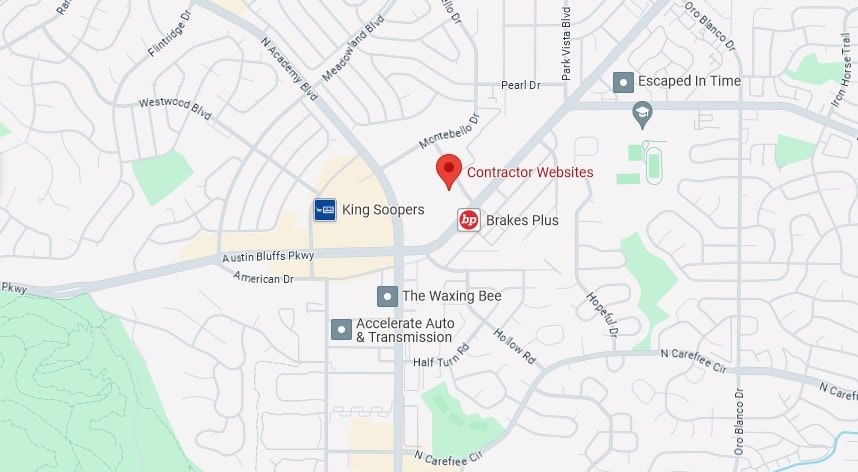The Key Features of a Successful Contractor Website: Building Your Digital Foundation
In the competitive landscape of the construction industry, a contractor website acts as a crucial touchpoint for potential clients. It's not just a digital brochure. And if it is for you, you are missing out. Your website is a system—an essential tool for showcasing your expertise, building trust, and converting visitors into leads. A successful contractor website balances aesthetics with functionality, ensuring that it not only captures the attention of visitors but also provides them with the information and user experience they need to make informed decisions. Here are the key features that are indispensable for a contractor website to stand out and effectively support business growth.
1. Professional and User-Friendly Design
The design of your website should reflect the professionalism and quality of your work. A clean, modern layout with intuitive navigation makes it easy for visitors to find the information they're looking for. Additionally, a website that automatically displays properly on all devices is non-negotiable. This is called mobile responsiveness. You’ll want to ensure that your site looks great and functions smoothly across all devices and screen sizes. In addition, you want to make sure that your website loads quickly. One of the biggest reasons websites load slowly is pictures that haven’t been sized properly or compressed. A photo that is more than a couple hundred kilobytes is going to slow down the load time of your site. And if you have more than one photo on a page and they are all greater than 100kb think about how long it might take to load.
2. High-Quality Content and Portfolio
Content is king, and for contractors, this means showcasing your projects, services, and expertise through well-written and informative text, high-quality images, and possibly videos. This is a lot to cover so let’s start with your services. A website that has a bullet-point list of the company’s services is not going to gain visibility and isn’t going to provide any value to a customer visiting the website because it does not provide details. Don’t skimp on your website. To get to page one of Google, you want to have a different page for each of the significant services you provide. And when I say significant, I mean the ones that significantly contribute to your gross sales.
We did a website for a carpet cleaning company once, and as we were talking about the services, the owner said that in addition to carpet cleaning, she also cleans vents. I asked her how much money she makes on vent cleaning. It was insignificant compared to the carpet cleaning and remediation work. So, I told her rather than write a page about vent cleaning, let’s add a small graphic saying “Ask us about our Vent Cleaning Services.” This way, people know about it, but you’re not wasting valuable space on a service that only makes a few hundred dollars at best.
 Next, you want a detailed portfolio highlighting your work. This is so important I can’t even begin to tell you the importance. We have worked with numerous contractors who either had few pictures or their pictures were horrible. It is worth your time, money and effort to hire a professional photographer to photograph your work. If you can’t afford a professional photographer, go to the high school or local college and ask for a photography student who is good. Remember first impressions are everything. If the first page a customer comes to on your website is your portfolio (which can happen) and they see poorly lit photos with construction debris on the counters, ladders in the way, etc., it sets an impression, and not a good one.
Next, you want a detailed portfolio highlighting your work. This is so important I can’t even begin to tell you the importance. We have worked with numerous contractors who either had few pictures or their pictures were horrible. It is worth your time, money and effort to hire a professional photographer to photograph your work. If you can’t afford a professional photographer, go to the high school or local college and ask for a photography student who is good. Remember first impressions are everything. If the first page a customer comes to on your website is your portfolio (which can happen) and they see poorly lit photos with construction debris on the counters, ladders in the way, etc., it sets an impression, and not a good one.
In your portfolio, include before-and-after shots, if applicable. If you are a home builder, showcase the exterior and the most desirable rooms. For sure the kitchen, living room, family room and master bedroom. If the secondary bedrooms are just four walls and a door, you can skip those. But if they have cool features like a bookcase that is actually a door to a hidden room or closet, or they have beautiful trim or ceiling work, be sure to include those. You might even consider doing some virtual staging in the photos to show how the rooms would look with furniture.
If you have multiple photos for each project, create a project portfolio that includes a description of the project, what the client wanted to achieve with the project, and how your company met its objectives. And if you can, add a client testimonial right on the project portfolio page. This will significantly impact your credibility and persuade potential clients of your capability to deliver.
Last, consider a virtual tour of your finished project. Realtors use virtual tours all the time and they are definitely beneficial for potential buyers to envision the layout of a home.
3. Search Engine Optimized (SEO) Content
SEO is vital for making your website visible to potential clients searching online for contractors. Search engine optimization is an ongoing process and we'll cover that in another article. But, there are basic requirements that can be done when writing your content. These things include making sure the website is structured according to best practices so that Google knows what the website and each page on the site are about. Without SEO, your website will never be found unless the client knows your company name. And that defeats the purpose of being on the internet.
When writing content, you’ll want to incorporate relevant keywords (those are the search terms people use to find the service you are writing about.) You'll also want to write your articles with heading tags. Each page should have one H1 heading tag. This is the title that tells Google and the other search engines what your website is about. Under the H1, you can have multiple sub-headings marked as H2. Within an H2 subheading, you may also have multiple H3 subheadings. This hierarchy helps the search engines to understand what each paragraph is about. It also makes it easy for people to skim your content. In addition each page should have a meta description, and a page title. Each of these has specific requirements so you’ll want to have someone do these things that know best practices. Next, you'll want to ensure you add alt text for images. Alt text is actually read to people using screen readers. Having it on your site will help to improve your site's ranking on search engine results pages (SERPs). Local SEO strategies, such as listing your business on Google My Business and local directories, are also crucial for contractors looking to attract clients in specific geographic areas.
4. Clear and Accessible Contact Information
Your contact information should be one of the most accessible elements on your website. Include multiple contact methods—such as phone numbers, email addresses, and a contact form—on a dedicated contact page and also prominently displayed on the homepage and footer. We have personally found that having a form on each service page increases conversion rates. This ensures that potential clients can easily reach out to you at any point during their visit.
5. Customer Reviews and Testimonials
Social proof, such as customer reviews and testimonials, is powerful for building trust with potential clients. Dedicate a section of your website to showcasing positive feedback from satisfied customers. Video testimonials can be particularly effective, offering a genuine and personal touch.

6. Blog and Educational Content
A blog or resource section can significantly enhance the value of your website. By sharing your knowledge, tips, and insights related to your field, you not only provide valuable information to your audience but also position yourself as an industry authority. Regularly updated content can also improve your SEO efforts, driving more traffic to your site.
7. Trust Signals
Displaying affiliations, certifications, awards, and memberships with recognized industry organizations can enhance your credibility. These trust signals reassure potential clients of your professionalism and commitment to quality standards.
8. Call-to-Action (CTA) Buttons
Effective CTA buttons guide visitors towards taking the next step, whether it's requesting a quote, scheduling a consultation, signing up for a newsletter or simply learning more about your services. Ensure your CTAs are compelling and placed strategically throughout your site to maximize engagement and conversion.
9. Security and Fast Loading Times
A secure and fast-loading website is essential for a positive user experience. Implement HTTPS to protect your site and visitor data, and optimize your site's loading speed to prevent users from leaving out of frustration.
Conclusion
A well-crafted contractor website is more than just an online brochure; it's a pivotal tool for attracting clients, showcasing your work, and establishing your credibility in a competitive market. By incorporating these key features, you create a strong digital foundation that supports your business goals, enhances your online presence, and drives growth. Investing in a high-quality, feature-rich website is an investment in your business's future, paving the way for sustained success in the digital age.
Contractor Websites | Step-by-Step Guide to Building a Contractor Website


